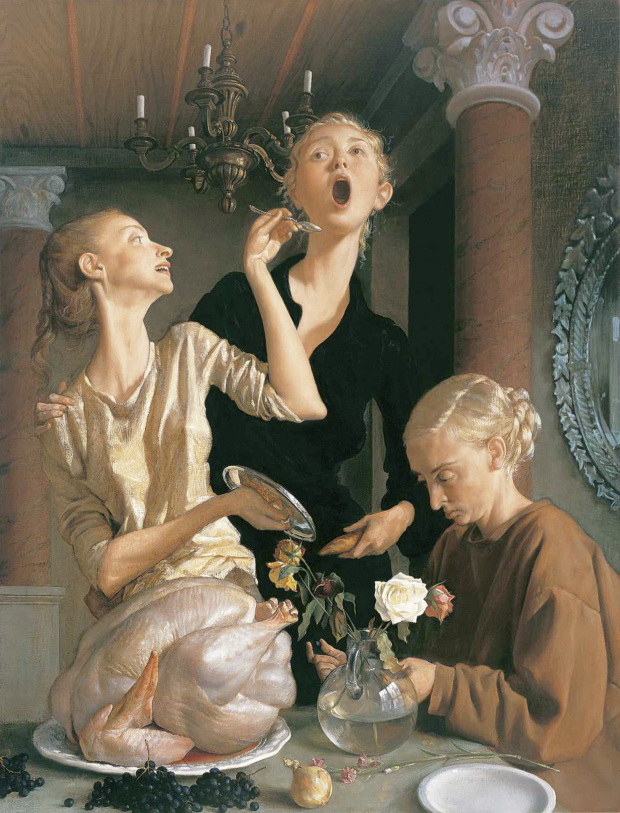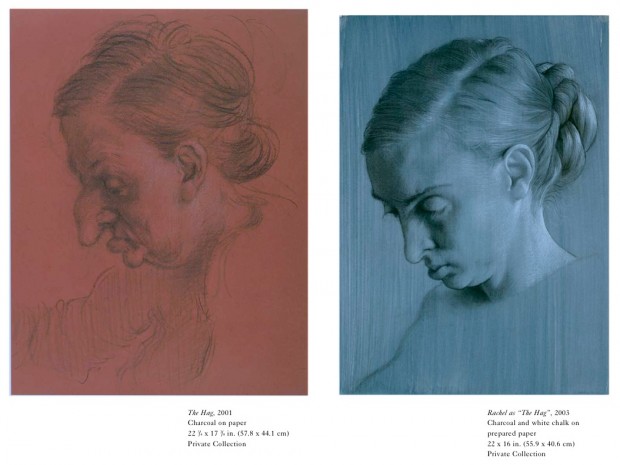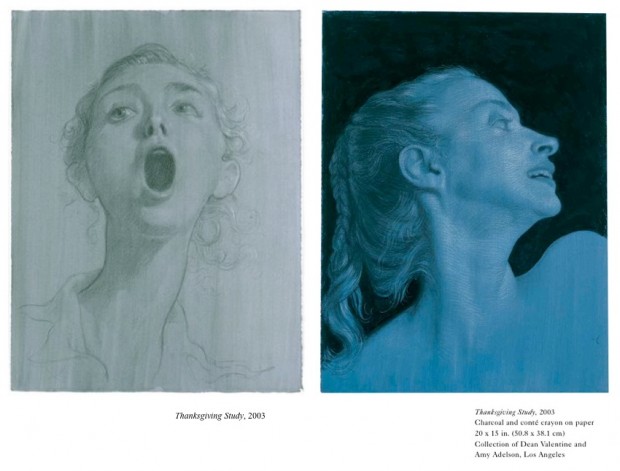An iconographic and text archive related to communication, technology and art.
☛Tate Online: “Thanksgiving” by John Currin, oil on canvas, 1729 x 1323 mm, painting. Lent by the American Fund for the Tate Gallery, courtesy of Marc Jacobs, 2004. © 2011, John Currin.
The hi-res reproduction depicted above comes from the book John Currin, with essays by Norman Bryson, Alison M. Gingeras, Dave Eggers; edited by Kara Vander Weg with Rose Dergan, published by Rizzoli International Publications, 2006, p. 327. See the official website (Gagosian shop). Preview available (PDF).
Here’s what John Currin had to say about this painting:
This was an idea that I had started before September 11, but it just didn’t work—it was a failed painting that sat around in my studio. I decided to retry the idea, and that was when Rachel got pregnant. The funny thing is that the painting took me exactly nine months to finish, and the painting turned into an allegory of Rachel’s pregnancy. Certain kinds of paintings were on my mind at the time— Dutch genre paintings, Velázquez’s bodegones—but as soon as I began, it became more about Rachel, and she posed for the figures a lot. When my painting goes well, it’s like rolling a ball down a hill: you try hard in the beginning, but then it takes on its own life and you let it go where it wants to go. Some things become allegorical, and other things are just about what you see. I had been told that my paintings were anachronistic, and so I wanted to do what I’d been accused of doing. That’s why I included the old-fashioned mirror and the Corinthian columns. (John Currin, 2006, p. 327)
From the same book, we are offered some additional documents that were used in the making of this painting: popular Thanksgiving clip-art from Currin’s archive and a photo of his pregnant wife posing in front the painting (p. 326), two drawing studies of for the profile of the character named “The Hag” (p. 328) and two more drawing studies for each of the two other women depicted in the scene (the one on the right comes from the book, on p. 329, while the one on the left was found online at Food Culture Index).
More resources online about John Currin’s “Thanksgiving” painting, along with some relevant quotes:
- VillageVoice.com: “Agent Provocateur” by Kim Levin, November 25, 2003. Excerpt:
“Thanksgiving”, his most recent painting, is a timely tour de force. The whole elaborate composition is on the verge of being sucked into the gaping oval hole of the central woman’s mouth. A woman at the left attempts to spoon-feed her with an empty spoon, while on the right, a third vacant woman contemplates another black hole: the cavity of the unpalatable raw turkey that upstages the women. We’ve come a long way from Norman Rockwell, yet he and Currin share a peculiarly American social vision. It’s a disconcerting parable and parody of consumption, lack of fulfillment, and insatiability.
- Thought On Art: “John Currin”, page no. 5, by Clifford Elgin. An short analysis of Currin’s work in general and, on page 5, more specifically of the painting “Thanksgiving”:
Currin, in ‘Thanksgiving,’ uses all of art history to and the leniency of our Post Modern culture to produce something fully new for our age. First of all we have the figures of the three ladies that are cleverly misshapen. They’re necks are too long, their heads are too large, these are figures that could not exist in reality. But Currin is pulling it off thanks in a large part to the old masters techniques of accurate depiction being subjugated by the more nuanced and searching quality of the abstract expressionists; the steps they have taken to devolve and reconstruct the figure.
- The New York Times: “ART REVIEW – With Barbed Wit Aforethought” by Michael Kimmelman, Nov. 21, 2003. Excerpt:
Like much of Mr. Currin’s work, the image is cruel and tender. It seems plain as day and somehow not, and it’s finally about the pleasure of painting — pushing pigment around to make you look twice. Lately, Mr. Currin has been making works in which the pervasive malaise, less licentious and misogynous, is now subsumed in a larger project to fashion a more luxurious and durable brand of surrealism.
Works like “Thanksgiving” and “The Lobster” suggest cartoons, Norman Rockwell and Van Eyck, at the same time they flatter the eye with certain passages: the pool of blood below the uncooked turkey; the reflections of yellow from a bunch of lemons in a glass pitcher; a lobster’s antenna that looks like a single curling hair on the woman burdened by a still life of fruit, bread, fish and a stringless violin. - New York Observer: “Drawings of a new ‘Old Master’” by Zachary Woolfe, June 17, 2009.
The show contains memorable drawings of the two extraordinary images Mr. Currin has created: an ineffably sad, beautiful picture of a girl gesturing to her shirt, which has a large heart-shaped cutout; and Thanksgiving, an end-of-empire trio of emaciated women, the center figure with her mouth gaping open, ready to receive a piece of uncooked turkey offered by one of the others. The drawings don’t add appreciably to our understanding of his work or practice, but, with softer lines and gentler, sketchier imagery than the sometimes hyperrealistic paintings, they do participate in a general smoothing-over of Mr. Currin’s reputation that might make him easier to take for some collectors.
- Finally, for more artwork inspired by Thanksgiving, see “Black Thursday: Depictions of Thanksgiving” by Jeriah Hildwine, Nov. 25, 2009. Currin’s “Thanksgiving” is mentioned as well.
Previously on Aphelis: John Currin’s Paintings
- By Philippe Theophanidis
- on
- ― Published in Art, Painting
- Tagged: animal, glutony, John Currin, Thanksgiving, woman




